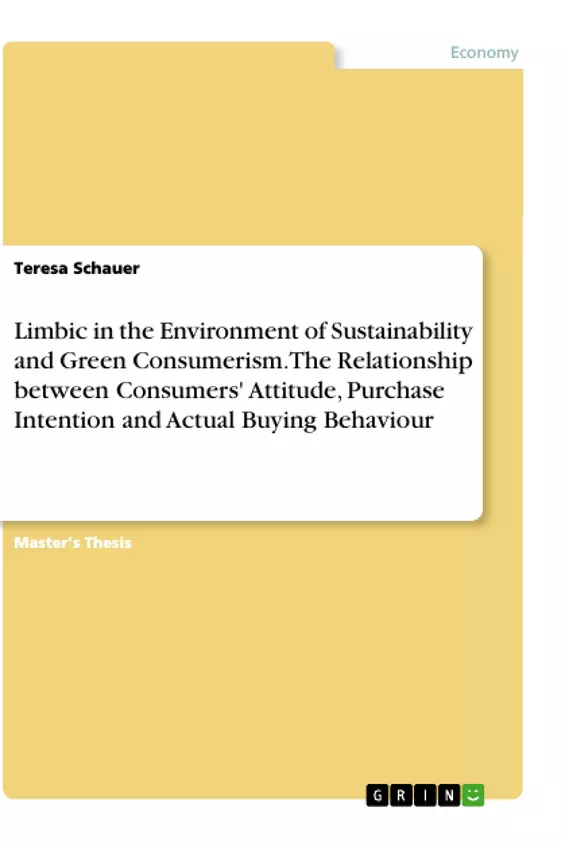The responsible use of resources and the environment as well as further aspects of sustainability play an important role in the modern world of trade. This thesis aims to present the most important aspects and factors regarding these aspects and to research the underlying consumer behaviour. In the first part, the findings from the literature that relate to the topics of sustainable development, Corporate Social Responsibility and green consumption are described. Furthermore, consumer behaviour and the associated connections between attitude, purchase intention and buying behaviour are examined and introduced to the neuromarketing concept of Limbic®.
In the second part, current insights are gained through the method of quantitative research, which should generate a better understanding of the modern customer. Finally, the theoretical findings are related to the new survey results and further analysed focusing the various Limbic® Types. Finally, a development of the CSR-fields in Retail is given as well as recommendations for action and possibilities for retailers are derived and optimisation potentials are presented.
Inhaltsverzeichnis (Table of Contents)
- Abstract
- List of Abbreviations
- List of Figures
- 1. New Directions
- 1.1 Relevance of the Topic and Problem Statement
- 1.2 Aim of the Thesis
- Part 1: Theoretical Framework
- 2. Government and Society
- 2.1 Sustainability
- 2.2 Sustainable Development
- 2.3 Corporate Social Responsibility
- 3. Consumer Behaviour
- 3.1 Sustainable Consumption
- 3.2 Green Consumerism
- 3.3 Attitude-Intention-Behaviour Relationship
- 4. Neuromarketing
- 4.1 Gruppe Nymphenburg Consult AG
- 4.2 The LimbicⓇ Model
- 4.3 LimbicⓇ Types
- 4.3.1 The Harmoniser
- 4.3.2 The Traditionalist
- 4.3.3 The Disciplinarian
- 4.3.4 The Performer
- 4.3.5 The Adventurer
- 4.3.6 The Hedonist
- 4.3.7 The Open-Minded
- 4.3.8 Summary
- Part 2: Empirical Part
- 5. Methods
- 5.1 Method of Quantitative Research
- 5.1.1 Structure
- 5.1.2 Sample Characteristics
- 5.1.3 Research Objectives
- 5.2 Hypotheses
- 6. Results
- 6.1 General Findings
- 6.2 Green Lifestyle
- 6.3 Drivers and Barriers
- 6.4 Products, Brands and Communication
- 6.5 Self-anchoring
- 6.6 Hypotheses Findings
- 6.7 Attitude-Intention-Behaviour Relationship
- 6.7.1 Gender Differences
- 6.7.2 Effects of Attitudes and Intentions
- 7. Influences of LimbicⓇ Types
- 7.1 General Findings
- 7.2 Attitude-Intention-Behaviour Relationship
- 7.3 Summary
- 7.3.1 The Harmoniser
- 7.3.2 The Traditionalist
- 7.3.3 The Disciplinarian
- 7.3.4 The Performer
- 7.3.5 The Adventurer
- 7.3.6 The Hedonist
- 7.3.7 The Open-minded
- 8. Discussion
- 8.1 Managerial Implications
- 8.2 Limitations and Directions for Further Research
- 9. Trade is Change
- 10. List of References
- The role of sustainability and corporate social responsibility (CSR) in the modern retail environment
- The influence of consumer behaviour and attitude towards sustainable consumption
- The application of the LimbicⓇ model to understand consumer behaviour in the context of sustainability
- The relationship between attitude, purchase intention and actual buying behaviour in relation to green consumerism
- The development of CSR fields in retail and potential strategies for optimizing sustainable practices.
- Chapter 1: "New Directions" introduces the relevance of the topic and problem statement, as well as the aim of the thesis. This chapter sets the stage for the research, highlighting the growing importance of sustainability and green consumerism in the retail environment.
- Chapter 2: "Government and Society" explores the concepts of sustainability, sustainable development, and corporate social responsibility (CSR). This chapter provides a foundational understanding of the broader context within which sustainable consumption is embedded.
- Chapter 3: "Consumer Behaviour" focuses on sustainable consumption and green consumerism, examining the relationship between attitude, purchase intention, and buying behaviour. This chapter delves into the psychological and sociological aspects that influence consumer choices.
- Chapter 4: "Neuromarketing" introduces the LimbicⓇ model developed by Gruppe Nymphenburg Consult AG. This chapter explores the application of this neuromarketing concept in understanding consumer behaviour and its relevance to sustainability.
- Chapter 5: "Methods" outlines the methodological approach used for the quantitative research, including the structure, sample characteristics, research objectives, and hypotheses. This chapter provides transparency and ensures scientific rigor for the study.
- Chapter 6: "Results" presents the findings of the quantitative research, focusing on general findings, green lifestyle, drivers and barriers to green consumption, products, brands, and communication, self-anchoring, hypotheses findings, and the relationship between attitude, intention, and behaviour.
- Chapter 7: "Influences of LimbicⓇ Types" analyses the research findings through the lens of the LimbicⓇ model. This chapter explores how different LimbicⓇ Types influence consumers' attitudes, intentions, and behaviour in the context of sustainable consumption.
- Chapter 8: "Discussion" provides managerial implications and outlines limitations and directions for further research. This chapter offers practical insights for retailers and researchers, highlighting areas for future exploration.
Zielsetzung und Themenschwerpunkte (Objectives and Key Themes)
This thesis explores the relationship between consumers' attitudes, purchase intentions and actual buying behaviour in relation to sustainable consumption. It aims to provide a comprehensive analysis of the key factors influencing consumer behaviour in the modern context of sustainability and green consumerism.
Zusammenfassung der Kapitel (Chapter Summaries)
Schlüsselwörter (Keywords)
The thesis focuses on the intersection of consumer behaviour, sustainability, and green consumerism. Key concepts include LimbicⓇ Types, attitude-intention-behaviour relationship, sustainable development, corporate social responsibility, and neuromarketing. The research investigates the factors influencing consumer choices in the context of sustainable practices and explores the role of the LimbicⓇ model in understanding these choices. This study aims to provide insights into the complexities of green consumerism and its implications for modern retail.
- Arbeit zitieren
- Teresa Schauer (Autor:in), 2020, Limbic in the Environment of Sustainability and Green Consumerism. The Relationship between Consumers' Attitude, Purchase Intention and Actual Buying Behaviour, München, GRIN Verlag, https://www.grin.com/document/1151414



